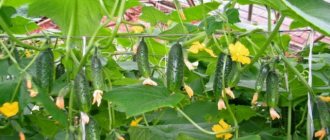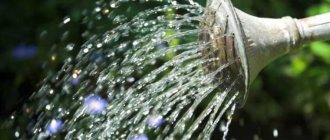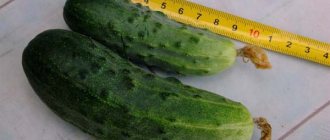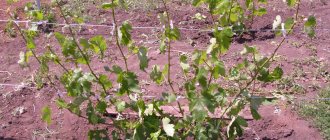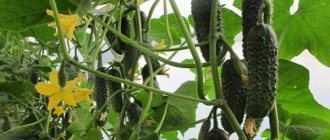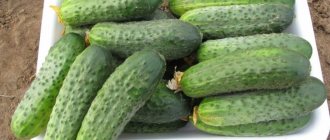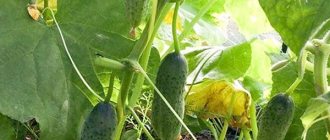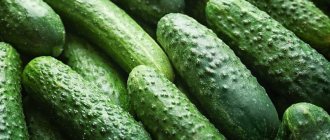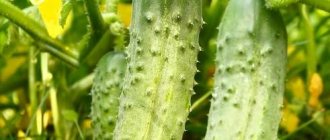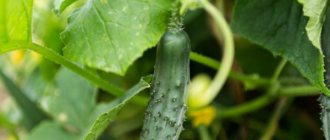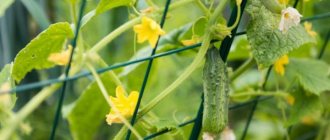Description of the variety
The Russian variety “Palchik” belongs to the group of bee-pollinated and early-ripening varieties. Universal purpose allows you to use the harvested crop without restrictions. The taste is very high. Fruiting occurs 42-46 days after planting in a permanent place.
The plant is disease-resistant and practically not susceptible to downy mildew. Cucumber bushes have increased cold resistance and can easily tolerate slight drops in temperature in the spring, as well as early autumn cold.
The length of the elongated cylindrical green is on average 11 cm. The surface has a fairly sparse and large tuberculation. The pulp of ripe greens is very dense, juicy, with a pronounced crunch and a bright aroma. The average weight of greens is 117 g.
Growing cucumbers yourself
The crop can be sown either by direct sowing of seeds directly into the ground or by planting seedlings. Sowing can be done with both dry and germinated seeds - they are germinated if it is necessary to reduce the germination time. And preliminary cultivation of seedlings is required when they want to get an early harvest of cucumbers.
Before planting cucumbers, it is important to highlight some features of the Palchik variety:
- The stems of the cucumber can climb onto a support, and the branches can reach a length of 1 to 3 m.
- Since it is a heat-loving plant, it grows best in direct sunlight for at least a few hours a day. Along with this, it is necessary to water the plant so that the roots never remain dry.
Seedling method
Before you start growing cucumber seedlings, you need to correctly determine the time for sowing the seeds. This depends on when stable warmth usually sets in in a given area and it becomes possible to plant plants in a permanent location. For example, if seedlings are planned to be planted on May 1, then the seeds need to be sown 35 days before (March 25).
Important! Cucumber seedlings should not outgrow, as overgrown plants do not take root well in a new place. The maximum period for growing cucumber seedlings in pots is 30 days from the moment the seedlings appear above the soil.
- Seedlings love loose, fertile soil. You can mix the soil mixture yourself, and it is best to do this in the fall, in reserve. A good soil mixture is obtained from 2 parts chernozem, 1 part sand, 1 part deciduous soil and 1 part humus. If possible, you can add a little wood ash, previously sifted through a sieve.
- Containers with a volume of at least 0.5 liters (beer glasses, flower pots, large-volume peat cups) are suitable as containers for growing seedlings. Peat cups are optimal - plants can be planted in the ground with them, and in the future the roots will easily grow through the peat walls soaked in the soil. When transplanting, seedlings should be removed from other planting containers very carefully, turning the container upside down and holding the stem with your fingers, removing the container from the roots with gentle movements, turning it clockwise and up.
- Before sowing, fill the pots with soil so that there is a small gap between the soil and the side of the pot. The free space will allow you to water the plants without fear that the water will overflow over the edge of the pot.
- Sow 2 seeds in each pot, placing them at a distance of 2 cm from each other. A double seeding rate serves as protection against poor seed germination. Subsequently, one of the shoots will be removed, leaving a stronger plant for further growth. The depth of planting seeds in the soil is 1.5–2 cm.
- Water the soil in the pots a little, then cover each pot with a plastic bag and put it in a warm place until the seeds germinate.
- After the cucumbers have sprouted, move the planting containers closer to the light, on a windowsill or seedling table. In the first half of the growing period, plants may lack natural light and will need artificial lighting using a fluorescent lamp or phytolamp. Artificial lighting should be turned on in the morning and evening, from 8:00 to 10:00 and from 18:00 to 20:00.
- The temperature in the room where seedlings are grown should not fall below 18°C. It is also undesirable to set the temperature above 25°C - this will cause rapid growth of the stem to the detriment of the root system. The optimal growing temperature is 20... 22°C.
- If the room where the seedlings are grown is warm, they need to be watered daily.
Watering should be moderate. It is very good to use melted snow or rainwater for irrigation. If this is not possible, tap water that has been standing for several days will do. If the room is cool, the frequency of watering should be reduced. The moisture needs of plants are determined by how dry the top layer of soil in the pot is. Waterlogging of the soil in combination with cold air will invariably cause the appearance of fungal diseases on seedlings. Did you know? With the help of cucumber you can correct such a nuisance as bad breath. Holding a slice of cucumber in your mouth for 30 seconds allows the phytochemicals in the vegetable to kill the bad bacteria that creates the off-putting odor. - As soon as the daytime air temperature outside stops falling below 20°C (from about mid-April), it is necessary to begin hardening the seedlings, for which you take the containers outside and place them in partial shade. Seedlings should not be exposed to the sun, as the sun's rays will burn the tender leaves. The duration of the first hardening sessions does not exceed 30 minutes. The time the seedlings spend outside should be gradually increased so that after 10 days the cucumber seedlings can stand outside during the entire daylight hours and be brought indoors only at night.
Cucumber seeds germinate best at a temperature of 20...25°C. It is safer to plant cucumbers with seeds directly into the ground, since the root system of the seedlings may be damaged during transplantation.
Before planting, you need to pay attention to the soil. The crop grows best in fertile soil. The bed is well fertilized with organic matter and drainage is arranged so that excess moisture does not stagnate in the roots of the plants. Optimal soil pH readings are 5.5-6.8.
How to sow cucumbers correctly:
- Pre-select a place for growing cucumbers. The bed should be located in the sun or not be completely in the shade.
- Remove the top fertile layer of 15–20 cm from the surface of the bed and set it aside, then lay drainage at the bottom of the resulting ditch. Coarse branches of trees or bushes, last year's sunflower or corn stalks can be used as drainage.
- Place organic fertilizers (cattle, poultry or other domestic animal manure) on top of the drainage, water well, and fill in the previously removed fertile soil as the top layer of the “sandwich.”
- Depending on the width of the plot, make the beds in 1 or 2 longitudinal planting furrows for sowing seeds. If you are planning a trellis growing method, then on a bed 1 m wide you need to mark two planting furrows with a distance between them of 50 cm and a distance of 25 cm from the longitudinal edge of the bed to each of the furrows. Sow seeds in both planting furrows with an interval of 20 cm each. from each other and staggered in relation to the opposite row. The depth of the planting furrow is 2–3 cm. In a bed 50 cm wide (for trellis growing), only 1 planting furrow should be made with a distance between seeds in a row of 10 cm.
- Before planting, water the planting furrows well at the rate of 1 liter of water per 1 linear meter of furrow.
- Next, spread the seeds along the wet planting furrows at the above interval between them and cover them with soil level with the surface of the bed.
Did you know? There are varieties of cucumbers whose fruit length reaches from 70 cm to 1 m. Such long cucumbers, for example the Chinese miracle variety, when grown on a trellis under the influence of gravity, grow fruits that look like thin long sticks, and when grown on in the “spread out” bed, their fruits twist into bizarre spirals, like snakes. - It is recommended to cover the bed with non-woven material (spunbond, agrofibre), doing this not “tightly”, but with some overlap, taking into account the future growth of young plants. Thanks to this, moisture from the soil does not evaporate under the sun and young shoots are warm at night under cover. Agrofibre is not removed for watering plants, as it does not prevent moisture from reaching the soil. The cover is removed when young plants need to be weeded or tied up, after which the spunbond can be returned to its place or cultivation can continue without the use of agrofibre.
- Install a longitudinal vertical trellis in the center of the bed. The optimal height of such a support is from 1.5 to 2 m. Young plants need to be weeded and tied to a trellis. In the future, the plant itself will cling to the support, but the gardener must keep this process under control and direct the cucumber vines in the right direction, and, if necessary, tie them up manually.
- When the cucumber vines reach the height of the trellis, they must be thrown to the other side or the growth point of the main stem must be pinched. Due to this pinching, the lateral stepsons begin to rapidly develop, on which an additional crop of gherkins is formed.
The described variety is recommended to be grown on vertical trellises. If a gardener grows plants in a greenhouse or greenhouse complex with a high ceiling, then breeders recommend pinching the main vine of the bush above the trellis.
The room temperature should be maintained at about 22°C.
You need to water the bushes every day, but with small portions of water. The soil under the bushes should not dry out, but the soil in the garden bed should not be allowed to become too wet, as this will lead to the death of the plants. Watering is carried out with warm water, standing under the rays of the sun. It is recommended to carry out watering activities early in the morning, before sunrise.
If a gardener has planted seeds or transplanted seedlings into beds, then for the first 14 days after germination, the plants require fertilizing with nitrogen fertilizers and organic matter (peat or manure). The second time the bushes are fed with phosphorus fertilizers during flowering. After the fruits appear, it is recommended to introduce complex mixtures containing nitrogen and potassium into the soil in the beds.
If the thermal regime is disturbed, then foliar feeding is used. When weak, small fruits develop on the bushes, you need to add mullein to the soil, and then feed the bushes with urea or use humus for these purposes.
To protect plants from garden pests and various diseases, it is necessary to carry out preventive treatment of the bushes. For this purpose, various chemical drugs and poisons are used.
Advantages and disadvantages
The “Finger” cucumber has many advantages and is almost completely free of disadvantages:
- excellent taste and beautiful appearance of greens;
- good transportability;
- long-term fruiting exceeds 60 days;
- bunching of cucumber ovaries;
- wide area of zoning;
- tolerance to downy mildew.
Average total yields, if agricultural practices are followed, can reach 6.8 kg/m2.
Pros and cons of the variety
Many vegetable growers and gardeners prefer the Palchik variety due to the list of its positive characteristics. As a rule, experts highlight the following description of the benefits of cucumbers.
pros
- Increased level of productivity of the variety (up to 10 kg of fruits are collected from 1 bush);
- Availability of seeds for the next sowing;
- Cucumbers are distinguished by long-term fruiting;
- Strong immunity to most diseases characteristic of the culture;
- Quite fast ripening of fruits;
- Variety resistance to cold conditions;
- Excellent taste characteristics of the variety;
- Cucumbers are versatile in use.
Minuses
Despite the fact that the breeders who worked on the creation of the Palchik variety claim that the variety has no drawbacks, growing experience suggests the opposite. As a disadvantage, vegetable growers note the overgrowth of fruits if they are not collected in a timely manner.
Landing rules
There are no difficulties in planting cucumbers of this variety, but in order to get a rich and tasty harvest, you must follow certain rules:
- There are two types of planting cucumbers of this variety: seeds or seedlings. In central Russia, cucumbers are planted in late May or early June;
- Before planting, it is recommended to warm up and soak cucumber seeds;
- the soil for planting cucumbers should be rich in high-quality humus, without stagnant moisture;
- the optimal depth for sowing prepared cucumber seeds into the soil is a depth of 2-3 cm;
- when planting seedlings in a greenhouse or greenhouse, the plants are distributed at an interval of at least 35 cm;
- the best sowing scheme is 50x30 cm with a depth of 3-4 cm;
- high-quality seedlings should be at least 25 cm high and have about five leaves.
Ready seedlings need to be planted when the soil on the ridges has warmed up well enough from the sun's rays. Overgrown seedlings should be deepened significantly.
Harvesting and storage
It is recommended to collect the variety Finger f1 every day. This procedure is carried out so that the formed fruits do not interfere with the development of new ones.
The fruits of the Palchik variety must be stored in a room whose temperature does not exceed 4 degrees Celsius: in the basement or in the cellar. If cucumbers are intended for fresh use, they are placed in the refrigerator, where they will remain for about 7 days without loss of appearance and taste.
To prevent cucumbers from rotting, they are placed in boxes. Such containers allow the necessary amount of oxygen to pass to the fruits. If any cucumber begins to rot, it must be removed immediately. It is also necessary to remove cucumbers that came into contact with the rotting vegetable, since they could have become infected.
Features of care
Cucumber “Finger” is an indeterminate, strongly climbing and medium-branched plant. Its height reaches 2-2.5 m, which somewhat complicates the process of caring for it:
- cucumbers of this variety require growing on vertical trellises;
- when growing in a high greenhouse or on greenhouse beds, it is recommended to pinch the main cucumber vine above the trellis;
- the optimal temperature regime for growth, development, and abundant fruiting of cucumbers is + 21-23°C;
- watering should be quite frequent, and it is recommended to use only sun-warmed water;
- in the first two weeks, after sprouting or transplanting seedlings to a permanent place, cucumbers need enhanced care and nitrogen nutrition, which will allow the plants to grow stronger and gain weight;
- at the stage of mass flowering, phosphorus fertilizers should be used for fertilizing;
- the transition to the active growing season involves the application of nitrogen-potassium fertilizers to the cucumbers;
- Foliar fertilizing, which is especially relevant when the thermal regime is disrupted, shows high efficiency;
- In case of poor fruit filling, preference should be given to active fertilizing with mullein, and periodically additional fertilizing of plants with urea or humus should be carried out.
To successfully protect cucumbers in greenhouses and open ground from pests and diseases, it is recommended to carry out comprehensive preventive treatment of plants. Not only strong chemicals have a good protective effect, but also completely harmless products, including decoctions of tomato tops and infusions of potato tops, which help rid plants of aphids, mites, and leaf-eating caterpillars.
The greatest effect in case of mass infestation of plants by pests is obtained by spraying cucumber bushes with solutions based on karbofos.
You may also be interested in an article that describes the characteristics of cucumbers of the “Herman f1” variety.
Diseases and parasites
Despite the variety’s strong immunity to most cucumber diseases, Finger f1 cucumbers are still susceptible to diseases such as root rot, bacteriosis and mosaic. Let's consider a description of all the listed diseases and ways to combat them.
Root rot
Root rot is an infection that affects a plant after it is transplanted. When affected by root rot, the plant wilts, the stem becomes thinner, and cracks form. Darkening of the root system of the plant, its softening and yellowing of the leaves are also observed. To combat root rot, chemical preparations “Alirin-B”, “Previkur” and “Gamair” are used.
Bacteriosis
Bacteriosis is a disease that results in a slowdown in plant development, deterioration in leaf assimilation and decreased fruit formation. Brown spots also form on the leaves, which soon acquire an oily consistency. To combat bacteriosis, the substances “Champion” and “Kuproksat” are used.
Mosaic
Mosaic is an infection that appears during the growing of plant seedlings. With mosaic, there is the formation of small warts on the leaves, a decrease in the number of leaves, a significant decrease in the number of flowers and shortening of internodes. To combat mosaic, it is recommended to use chemical preparations “Aktara”, “Aktellik”, as well as Burgundy liquid.
How to grow cucumbers (video)
Even in dry years and in the absence of regular, full watering, the greens of the “Finger” cucumbers are not prone to the accumulation of bitterness. Cold nights and short-term cooling also do no harm, although new hybrids and highly resistant varieties located on neighboring ridges often manage to become hypothermic and get sick, significantly losing yield. Almost all gardeners who grow cucumbers called “Finger” believe that this wonderful variety is worthy of a place in any home garden.
Optimal growing conditions
To grow Finger cucumbers in open ground, you need to choose a place protected from direct sunlight during periods of increased solar activity. According to recent studies, more intensive growth of greens occurs in the dark.
The bed where bee-pollinated cucumbers of the Palchik variety will grow should be located in a windless place, so that gusts do not blow away the pollen that is attractive to insects. Cucumber bushes growing in a draft will be visited by bees much less often.
To prevent various diseases and obtain a rich harvest every year, it is necessary to follow the rules of crop rotation and not plant the same crop for several years in one place. Gradually, “soil fatigue” occurs, there are fewer nutrients in the soil, and pathogens that overwintered along with the remains of the previous season’s plants may be present.
To successfully grow cucumbers of the Palchik variety, the soil should be loose, airy, and moderately moist. It is not recommended to place cucumber beds in places where groundwater accumulates; such planting is fraught with rotting of the root system and loss of the entire crop. In an environment that is too humid, many fungal diseases are likely to develop. Light sandy loams and loams are considered the most suitable for cultivating Palchik cucumbers.
How to grow a variety yourself
The Fingers variety is easy to grow. Caring for it is no different from caring for other varieties of cucumbers. Plants need to be regularly watered with a small amount of water, fertilized and provided with a comfortable air temperature. After heavy rain and each watering, the soil is loosened.
Planting by seeds and seedlings
The variety Fingers is grown by both seed and seedling methods.
If you choose the first method, then pay attention to the air temperature - it should not be lower than +15 °C. It is advisable to warm and soak the seeds
They are planted in the beds in mid-May. Before sowing, the bed is cleared of weeds, loosened and fertilized with fresh manure. Seeds are placed in the soil to a depth of 2-3 cm.
You can buy the substrate ready-made or make it yourself:
- turf soil - 4 parts;
- lowland peat – 4 parts;
- manure - one part;
- sawdust - one part.
Place the seeds in shallow longitudinal holes and cover them lightly with soil. Fertilizers are applied to nourish the soil. For 10 liters of soil you will need:
- urea – 6 g;
- superphosphate – 14 g;
- potassium sulfate – 8 g;
- magnesium sulfate – 2 g.
Growing in stages and care
Before the first shoots appear in open ground, the bed is covered with film.
Containers with seedlings are covered with polyethylene and taken to a room with a temperature of about +25 °C. After the first leaves appear, the room temperature is lowered by 5 °C. Seedlings need to be provided with lighting, a temperature of +20...23 °C, regular watering and nutritional supplements.
Cucumber Finger
In order not to spend money on new hybrid seeds, I bought cucumber seeds of the Palchik variety. Anyway, I grow it in the garden in an open area, the bees pollinate it. This is our Russian selection, somehow even this makes it calmer. The seeds are neat, but I germinated them at home, each seed in a glass to check germination. Later I planted it in open ground. Germination is good, and the seedlings have grown strong and strong. It is immediately obvious that they are unpretentious. The stems are thick, the leaves are large, and the climbing pattern is abundant. After the transplant there was no pain. I even read that powdery mildew does not affect them. This is an early ripening variety, 45 days from germination to the first cucumbers. They are even, smooth, neat due to their small size and tasty. They do not overgrow much, do not turn yellow, even if you miss harvesting for a couple of days, but no more. Otherwise, they will lose their shape and the taste will no longer be the same. There was never any bitterness, although the summer was hot, and it was not always possible to water on time.
This season I planted the “Finger” variety of cucumbers with my own seeds and there is almost no difference from purchased ones. Germination is just a little less. Especially for this purpose, I sprouted on gauze to see what kind of roots there would be and which ones would grow. The variety is good, very strong, the vines are powerful, they grow even in hot weather without frequent watering. You can't yawn with the harvest. After a couple of days they lose their shape, outgrow and become neither tasty nor beautiful. The cucumbers are smooth and even. Sweet both fresh and canned. They grow relatively quickly - 40-45 days. I don’t know how they will grow in a greenhouse, because this is not a hybrid or a self-pollinating variety.
I have been growing the “Finger” variety for several seasons. I'm pleased with how it behaves in open ground. The variety was bred by Russian breeders, so the plant is perfectly suited for germination in our area with its climate. The vegetable is a self-pollinating and quick-ripening cucumber. The harvest can be used in different ways: eaten fresh, used for preservation. Cucumbers begin to appear, on average, 45 days after planting. The plant is highly resistant to downy mildew. Resistant to diseases typical of cucumbers. I will highlight the main advantages of the variety: + attractive appearance, high taste; + suitable for transportation; + easy care; + no territorial restrictions for cultivation; + long fruiting, which exceeds 60 days. When planting, I follow simple rules: - I plant at the beginning of June or at the end of May; - I use seeds or seedlings; — I definitely warm and soak the seeds first; — I pre-fertilize the soil with humus and special fertilizers; — I plant the seeds in the ground to a depth of 2-3 cm; - Maintain a distance of at least 35 cm between plants.
Watering requirements
Cucumbers of the “Finger” variety love a humid environment. But you need to water carefully, following the advice of agronomists:
- Do not flood the roots. Stagnation of moisture around the plant causes fungal infection.
- Warm water. For watering, a barrel (container) is placed next to the ridge or greenhouse. Water is poured into it in the evening or in the morning so that during the day it becomes close to the ambient temperature. Cold water from a well, water supply or well will cause the ovary to drop, and the cucumber harvest will become much smaller.
- Evening and morning watering. The time for moistening the soil is selected according to the capabilities of the summer resident, the main thing is before exposure to bright sunlight, that is, during the period of shading of the bushes.
Tip: to ripen quickly and get an early harvest, cucumbers are grafted onto laginaria. In addition, the juiciness of the fruit will improve.
The taste of cucumbers depends on fulfilling the requirements. Reviews claim that the “Finger” variety will conquer experienced and novice vegetable growers - its positive characteristics are numerous.
Care, feeding and watering
Finger beds require standard care:
- You need to make sure that the soil is loose and free of weeds.
- The first three weeks after germination or transplantation, the plant must be fed with nitrogen-containing fertilizers. This will help enhance growth and allow the cucumber to get stronger.
- When flowers begin to appear on the stem, the cucumber will need to be fed with phosphorus-containing fertilizer.
- During fruiting, humic fertilizers or mullein are suitable for feeding and better growth of cucumbers. The procedure is carried out 3-4 times during the entire fruiting period.
One of the fertilizer recipes for feeding a plant during fruiting: dilute half a liter of mullein and about a teaspoon of potassium sulfate in a bucket of water heated in the sun.
Water the plant at the root, in the morning or evening, with water that has settled and warmed in the sun. You need about a bucket of water for one adult bush.
Tip : during hot weather, it is useful to spray cucumber leaves with water. This should be done in the evening, when the sun is already setting, so that droplets of water on the leaves do not act as lenses and burn them. The water must be settled and at ambient temperature. This procedure will prevent the leaves from yellowing and wilting.
You can start tying cucumbers when the vine reaches a height of 30 cm. By this time, it will already have 5-6 leaves and tendrils will appear. It is better to start gartering early in the morning, before the sun begins to warm up, or in cloudy weather. Do not use thin ropes, they can damage the stem. It is best to use material 2 cm wide. The vertical trellis is installed in advance so as not to damage the root system of the bush. When forming side branches, it is advisable to tie them to a separate rope so as not to touch the central stem. If the vine grows beyond the height of the trellis, its crown must be pinched to stop the growth.
How to properly plant seeds for seedlings
The cucumber variety Finger is planted in the same way as other varieties:
- Seeds should be placed with their nose up, at an angle of no more than 45 degrees. Thus, from the spout the root will bend and grow downwards. As soon as the sprout appears, it will split the seed and will be able to further develop without any obstacles.
- The cracked seed will cling to the ground and remain in it. If you initially lower the spout down, the seed will interfere with the full growth of the plant and may come out of the ground along with the greenery. It turns out that the sprout will spend additional energy to fight the peel.
- The seeds should not be buried too deeply; a thin layer of soil of 1 cm will be sufficient.
If the seed is deep, then the moment of germination may be delayed, since the greenery will not come out of the ground until the lateral roots are formed.
- To create favorable conditions for the germination of seeds for seedlings, the ground must be covered with ordinary newspaper, a layer of several sheets. The newspaper needs to be sprayed periodically to keep it moist and allow oxygen to reach the seeds. Without the right amount of air and moisture, the plant may die.
- Next, the container with the planted seeds should be placed in a room where the air temperature reaches 25 degrees. After the first shoots have appeared, the newspaper is removed. During this period, you need to stop watering the seedlings, since they now have enough moisture.
Reviews
On the Internet there are many positive reviews about the Fingers variety, which confirm its characteristics.
Maria, Minsk: “This year I purchased “Palchiki” cucumber seeds. I planted them in open ground at the beginning of May, but covered them with white covering material, and removed them at the end of May. The seeds sprouted together. They grew and were pleasing to the eye. Interestingly, my cucumbers were exactly like in the picture. At one time I was away for a long time, we went on vacation, and upon arrival my cucumbers did not grow much, or rather they grew, but only in length and at the same time did not lose their attractive appearance, did not get fat or turn yellow. I used them to make a fresh salad.”
Tanya, Tyumen: “The variety doesn’t overgrow too much - that’s its beauty. Cucumbers with thin, rather prickly spines hold tightly to the branches, so I cut them off with scissors. The taste is good! The fruits are tender, juicy, and sweetish. I didn't eat bitters. The skin is thin."
Olga, Vitebsk: “Last year I tried a new variety of cucumbers, Fingers. I planted seedlings. Almost all the seeds sprouted perfectly. This certainly made me happy. I planted the seedlings in open ground. The cucumbers grew one to one. Handsome guys - strong, small. Crispy, the core is not watery, without bitterness. Towards the end of summer, I began to pickle the harvest. The cucumbers are small in size and fit perfectly in a liter jar. I took my simplest recipe. Cucumbers delighted the family not only in summer, but also in winter.”
Protection from diseases and pests
To prevent diseases, moderate watering is needed so that the roots do not sour. Compliance with crop rotation, protection from temperature changes and night dew, and preventive spraying with products containing copper or Fitosporin will also help.
Herbal infusions are prepared against parasites:
- onion peel;
- chopped garlic arrows;
- tobacco;
- chopped nightshade tops (tomato or potato).
Washing the leaves with a solution of laundry soap is also effective.
Working with seeds
In the photo you can see what the seeds of the “Finger” cucumber variety look like. They are no different from other hybrids. The shape is slightly convex, all the material is almost the same in size, but some are slightly smaller and narrower. This doesn't mean they are bad.
The seeds are laid out in the ground in a special way: with their nose up. It is advisable to prepare a hole and a flat plate for the seeds in advance. The seed is placed in the hole not vertically, but at an angle of 45C. From the hatched spout, the sprout will appear at an angle, it will be easier for it to cling to the ground, this method also creates convenience for the roots. They will be freed from the shell and will go deep into the soil and horizontally to the top layer. If cucumber seeds are placed lying down in a hole, the sprout will have to bend to get to the light. It is even more difficult to germinate if the spout points downwards.
The strength of the bushes and the speed of ripening of cucumbers depend on how much effort the seed spends on germination. Having spent all its strength to germinate outward, the sprout will be weak and sick. You should not immerse the seeds deeper than recommended - no more than 2-4 cm.
Tip: lateral roots form first, and then the sprout begins to develop, so you should carefully consider the composition of the soil.
After planting, some gardeners cover the ridge with newspapers in several layers. Watering is carried out directly onto the newspapers. This technology allows you to retain heat and moisture. Part of the newspaper will disintegrate, it will be left in the ground, and denser pieces are simply removed into manure; when they disintegrate, microelements will be added to the soil composition.
Planting finger cucumber seedlings in open ground
As soon as the warm weather has arrived and all the frosts are behind you, you can begin to transplant the seedlings into open ground.
The best period for this is the end of May. However, nights can be cool and therefore additional protection for young cucumbers should not be neglected. The distance between the bushes is about 30 cm, and between the rows about 60 cm.
To begin with, you can cover the plants with film. As soon as the night temperature has settled and no longer threatens frost, the secondary cover can be removed and cucumbers can be grown on a trellis.
